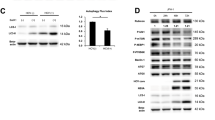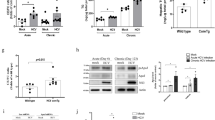Abstract
Hepatitis C virus (HCV) interacts extensively with host factors to not only establish productive infection but also trigger unique pathological processes. Our recent genome-wide siRNA screen demonstrated that IκB kinase-α (IKK-α) is a crucial host factor for HCV. Here we describe a new nuclear factor κB (NF-κB)-independent and kinase-mediated nuclear function of IKK-α in HCV assembly. HCV, through its 3′ untranslated region, interacts with DEAD box polypeptide 3, X-linked (DDX3X) to activate IKK-α, which translocates to the nucleus and induces a CBP/p300-mediated transcriptional program involving sterol regulatory element-binding proteins (SREBPs). This innate pathway induces lipogenic genes and enhances core-associated lipid droplet formation to facilitate viral assembly. Chemical inhibitors of IKK-α suppress HCV infection and IKK-α–induced lipogenesis, offering a proof-of-concept approach for new HCV therapeutic development. Our results show that HCV uses a novel mechanism to exploit intrinsic innate responses and hijack lipid metabolism, which may contribute to high chronicity rates and the pathological hallmark of steatosis in HCV infection.
This is a preview of subscription content, access via your institution
Access options
Subscribe to this journal
Receive 12 print issues and online access
$209.00 per year
only $17.42 per issue
Buy this article
- Purchase on Springer Link
- Instant access to full article PDF
Prices may be subject to local taxes which are calculated during checkout






Similar content being viewed by others
Accession codes
Change history
27 September 2013
In the version of this article initially published, the HCV core mutant (F24Y) virus used in Figure 4h and Supplementary Figure 8g and attributed as a gift from A. Patel was incorrectly named. The correct name of the virus is Y35A. The error has been corrected in the HTML and PDF versions of the article.
References
Liang, T.J., Rehermann, B., Seeff, L.B. & Hoofnagle, J.H. Pathogenesis, natural history, treatment, and prevention of hepatitis C. Ann. Intern. Med. 132, 296–305 (2000).
Liang, T.J. & Ghany, M.G. N. Engl. J. Med. 368, 1907–1917 (2013).
Rehermann, B. Hepatitis C virus versus innate and adaptive immune responses: a tale of coevolution and coexistence. J. Clin. Invest. 119, 1745–1754 (2009).
Syed, G.H., Amako, Y. & Siddiqui, A. Hepatitis C virus hijacks host lipid metabolism. Trends Endocrinol. Metab. 21, 33–40 (2010).
Herker, E. & Ott, M. Unique ties between hepatitis C virus replication and intracellular lipids. Trends Endocrinol. Metab. 22, 241–248 (2011).
Diamond, D.L. et al. Temporal proteome and lipidome profiles reveal hepatitis C virus–associated reprogramming of hepatocellular metabolism and bioenergetics. PLoS Pathog. 6, e1000719 (2010).
Horton, J.D., Goldstein, J.L. & Brown, M.S. SREBPs: activators of the complete program of cholesterol and fatty acid synthesis in the liver. J. Clin. Invest. 109, 1125–1131 (2002).
Waris, G., Felmlee, D.J., Negro, F. & Siddiqui, A. Hepatitis C virus induces proteolytic cleavage of sterol regulatory element binding proteins and stimulates their phosphorylation via oxidative stress. J. Virol. 81, 8122–8130 (2007).
Lerat, H. et al. Hepatitis C virus proteins induce lipogenesis and defective triglyceride secretion in transgenic mice. J. Biol. Chem. 284, 33466–33474 (2009).
Bowie, A.G. & Unterholzner, L. Viral evasion and subversion of pattern-recognition receptor signalling. Nat. Rev. Immunol. 8, 911–922 (2008).
Hayden, M.S. & Ghosh, S. Shared principles in NF-κB signaling. Cell 132, 344–362 (2008).
Perkins, N.D. Integrating cell-signalling pathways with NF-κB and IKK function. Nat. Rev. Mol. Cell Biol. 8, 49–62 (2007).
Senftleben, U. et al. Activation by IKKα of a second, evolutionary conserved, NF-κB signaling pathway. Science 293, 1495–1499 (2001).
Pasparakis, M. Regulation of tissue homeostasis by NF-κB signalling: implications for inflammatory diseases. Nat. Rev. Immunol. 9, 778–788 (2009).
Anest, V. et al. A nucleosomal function for IκB kinase-α in NF-κB–dependent gene expression. Nature 423, 659–663 (2003).
Birbach, A. et al. Signaling molecules of the NF-κB pathway shuttle constitutively between cytoplasm and nucleus. J. Biol. Chem. 277, 10842–10851 (2002).
Yamamoto, Y., Verma, U.N., Prajapati, S., Kwak, Y.T. & Gaynor, R.B. Histone H3 phosphorylation by IKK-α is critical for cytokine-induced gene expression. Nature 423, 655–659 (2003).
Huang, W.C., Ju, T.K., Hung, M.C. & Chen, C.C. Phosphorylation of CBP by IKKα promotes cell growth by switching the binding preference of CBP from p53 to NF-κB. Mol. Cell 26, 75–87 (2007).
Li, Q. et al. A genome-wide genetic screen for host factors required for hepatitis C virus propagation. Proc. Natl. Acad. Sci. USA 106, 16410–16415 (2009).
Zandi, E., Rothwarf, D.M., Delhase, M., Hayakawa, M. & Karin, M. The IκB kinase complex (IKK) contains two kinase subunits, IKKα and IKKβ, necessary for IκB phosphorylation and NF-κB activation. Cell 91, 243–252 (1997).
Akazawa, D. et al. CD81 expression is important for the permissiveness of Huh7 cell clones for heterogeneous hepatitis C virus infection. J. Virol. 81, 5036–5045 (2007).
Miyanari, Y. et al. The lipid droplet is an important organelle for hepatitis C virus production. Nat. Cell Biol. 9, 1089–1097 (2007).
Herker, E. et al. Efficient hepatitis C virus particle formation requires diacylglycerol acyltransferase-1. Nat. Med. 16, 1295–1298 (2010).
McLauchlan, J. Lipid droplets and hepatitis C virus infection. Biochim. Biophys. Acta 1791, 552–559 (2009).
Saito, T., Owen, D.M., Jiang, F., Marcotrigiano, J. & Gale, M. Jr. Innate immunity induced by composition-dependent RIG-I recognition of hepatitis C virus RNA. Nature 454, 523–527 (2008).
Rothenfusser, S. et al. The RNA helicase Lgp2 inhibits TLR-independent sensing of viral replication by retinoic acid-inducible gene-I. J. Immunol. 175, 5260–5268 (2005).
Zhang, Z. et al. DDX1, DDX21, and DHX36 helicases form a complex with the adaptor molecule TRIF to sense dsRNA in dendritic cells. Immunity 34, 866–878 (2011).
Oshiumi, H., Sakai, K., Matsumoto, M. & Seya, T. DEAD/H BOX 3 (DDX3) helicase binds the RIG-I adaptor IPS-1 to up-regulate IFN-β–inducing potential. Eur. J. Immunol. 40, 940–948 (2010).
Schröder, M., Baran, M. & Bowie, A.G. Viral targeting of DEAD box protein 3 reveals its role in TBK1/IKKɛ-mediated IRF activation. EMBO J. 27, 2147–2157 (2008).
Ariumi, Y. et al. DDX3 DEAD-box RNA helicase is required for hepatitis C virus RNA replication. J. Virol. 81, 13922–13926 (2007).
Randall, G. et al. Cellular cofactors affecting hepatitis C virus infection and replication. Proc. Natl. Acad. Sci. USA 104, 12884–12889 (2007).
Oshiumi, H. et al. Hepatitis C virus core protein abrogates the DDX3 function that enhances IPS-1–mediated IFN-β induction. PLoS ONE 5, e14258 (2010).
Angus, A.G. et al. Requirement of cellular DDX3 for hepatitis C virus replication is unrelated to its interaction with the viral core protein. J. Gen. Virol. 91, 122–132 (2010).
Reed, B.D., Charos, A.E., Szekely, A.M., Weissman, S.M. & Snyder, M. Genome-wide occupancy of SREBP1 and its partners NFY and SP1 reveals novel functional roles and combinatorial regulation of distinct classes of genes. PLoS Genet. 4, e1000133 (2008).
Ericsson, J. & Edwards, P.A. CBP is required for sterol-regulated and sterol regulatory element-binding protein-regulated transcription. J. Biol. Chem. 273, 17865–17870 (1998).
Oliner, J.D., Andresen, J.M., Hansen, S.K., Zhou, S. & Tjian, R. SREBP transcriptional activity is mediated through an interaction with the CREB-binding protein. Genes Dev. 10, 2903–2911 (1996).
Giandomenico, V., Simonsson, M., Gronroos, E. & Ericsson, J. Coactivator-dependent acetylation stabilizes members of the SREBP family of transcription factors. Mol. Cell Biol. 23, 2587–2599 (2003).
Brass, A.L. et al. Identification of host proteins required for HIV infection through a functional genomic screen. Science 319, 921–926 (2008).
Sessions, O.M. et al. Discovery of insect and human dengue virus host factors. Nature 458, 1047–1050 (2009).
Krishnan, M.N. et al. RNA interference screen for human genes associated with West Nile virus infection. Nature 455, 242–245 (2008).
Brass, A.L. et al. The IFITM proteins mediate cellular resistance to influenza A H1N1 virus, West Nile virus, and dengue virus. Cell 139, 1243–1254 (2009).
Heaton, N.S. & Randall, G. Dengue virus–induced autophagy regulates lipid metabolism. Cell Host Microbe 8, 422–432 (2010).
Mackenzie, J.M., Khromykh, A.A. & Parton, R.G. Cholesterol manipulation by West Nile virus perturbs the cellular immune response. Cell Host Microbe 2, 229–239 (2007).
Hsu, N.Y. et al. Viral reorganization of the secretory pathway generates distinct organelles for RNA replication. Cell 141, 799–811 (2010).
Farese, R.V. Jr. & Walther, T.C. Lipid droplets finally get a little R-E-S-P-E-C-T. Cell 139, 855–860 (2009).
Asselah, T., Rubbia-Brandt, L., Marcellin, P. & Negro, F. Steatosis in chronic hepatitis C: why does it really matter? Gut 55, 123–130 (2006).
Cai, D. et al. Local and systemic insulin resistance resulting from hepatic activation of IKK-β and NF-κB. Nat. Med. 11, 183–190 (2005).
Yuan, M. et al. Reversal of obesity- and diet-induced insulin resistance with salicylates or targeted disruption of Ikkβ. Science 293, 1673–1677 (2001).
Arkan, M.C. et al. IKK-β links inflammation to obesity-induced insulin resistance. Nat. Med. 11, 191–198 (2005).
Zhang, X. et al. Hypothalamic IKKβ/NF-κB and ER stress link overnutrition to energy imbalance and obesity. Cell 135, 61–73 (2008).
Romeo, S. et al. Genetic variation in PNPLA3 confers susceptibility to nonalcoholic fatty liver disease. Nat. Genet. 40, 1461–1465 (2008).
Hotamisligil, G.S. Inflammation and metabolic disorders. Nature 444, 860–867 (2006).
Baker, R.G., Hayden, M.S. & Ghosh, S. NF-κB, inflammation, and metabolic disease. Cell Metab. 13, 11–22 (2011).
Munger, J. et al. Systems-level metabolic flux profiling identifies fatty acid synthesis as a target for antiviral therapy. Nat. Biotechnol. 26, 1179–1186 (2008).
Feld, J.J. et al. Hepatic gene expression during treatment with peginterferon and ribavirin: identifying molecular pathways for treatment response. Hepatology 46, 1548–1563 (2007).
Acknowledgements
We thank Z. Hu, Y.-Y. Zhang, Y.-M. Li, E. Thomas, V. Gonzalez-Munoz and L. Holz for technical assistance, Y.-P. Wu of the National Institute of Diabetes and Digestive and Kidney Diseases (NIDDK) Confocal Microscopy Core for helping with confocal imaging and W.-P. Chen of the NIDDK Microarray Core Facility for DNA microarray analysis. We also thank A. Patel of the University of Glasgow for providing the HCV core mutant (Y35A) virus and C. Rice (Rockefeller University) for the 9E10 NS5A antibody and other reagents. This work was supported by the Intramural Research Program of the NIDDK, US National Institutes of Health (NIH). Primary human hepatocytes were provided by the NIH-funded Liver Tissue Procurement and Cell Distribution System (N01-DK-7-0004/HHSN26700700004C, principal investigator, S. Strom, University of Pittsburgh).
Author information
Authors and Affiliations
Contributions
Q.L. and T.J.L. conceived and designed the study. Q.L., V.P., S.K. and H.C. conducted experiments. Q.L., V.P. and T.J.L. analyzed data. Q.L. and T.J.L. wrote the paper with the input from V.P. T.J.L. supervised the studies.
Corresponding author
Ethics declarations
Competing interests
The authors declare no competing financial interests.
Supplementary information
Supplementary Text and Figures
Supplementary Figures 1–12, Supplementary Results and Supplementary Methods (PDF 1774 kb)
Rights and permissions
About this article
Cite this article
Li, Q., Pène, V., Krishnamurthy, S. et al. Hepatitis C virus infection activates an innate pathway involving IKK-α in lipogenesis and viral assembly. Nat Med 19, 722–729 (2013). https://doi.org/10.1038/nm.3190
Received:
Accepted:
Published:
Issue Date:
DOI: https://doi.org/10.1038/nm.3190
This article is cited by
-
Hepatocyte DDX3X protects against drug-induced acute liver injury via controlling stress granule formation and oxidative stress
Cell Death & Disease (2023)
-
Hepatitis C virus nonstructural protein 5A perturbs lipid metabolism by modulating AMPK/SREBP-1c signaling
Lipids in Health and Disease (2019)
-
Rewiring cellular networks by members of the Flaviviridae family
Nature Reviews Microbiology (2018)
-
Repurposing matrine for the treatment of hepatosteatosis and associated disorders in glucose homeostasis in mice
Acta Pharmacologica Sinica (2018)
-
Signalome-wide assessment of host cell response to hepatitis C virus
Nature Communications (2017)



